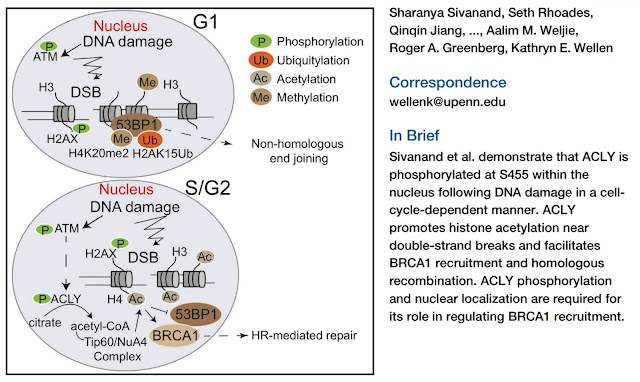Can vinegar repair damaged DNA?
Vinegar/acetate is produced in a healthy organism as the main product of the metabolism of intestinal bacteria in the large intestine. From there, it reaches the entire body through the bloodstream. I have already mentioned its positive effects on the metabolism of fats, carbohydrates, or perhaps the supporting cells of the nervous system several times. But today it will be of the highest caliber. Can acetate trigger the repair of our damaged DNA? In other words, prevent cancer? At first glance, it seems like nonsense. Such an ordinary thing as vinegar or sodium acetate? We would have known that a long time ago, right?
Today everyone knows how DNA looks. It is two strands twisted into a helix. The information stored in DNA is, therefore, redundant, each strand contains complete information. If one strand is somehow damaged, for example by radiation, the second strand in the exact same place contains information that allows the first damaged strand to be repaired.
Light repairable damage causes cellular senescence. Cell division stops. This is logical, because during cell division, individual DNA strands are untangled, and if one strand is damaged, the error cannot be repaired. This state, when the cell stops dividing, is called cellular senescence. In this state, the cell also changes its metabolism by limiting oxidative phosphorylation and preferring fermentation, i.e. anaerobic metabolism. This is due to the protection of DNA, as much less highly reactive substances are produced that would further damage DNA. The cell waits for the DNA repair program to be launched.
It is claimed that the state of cellular senescence is permanent. What causes it? I have already mentioned a study in which the authors ensured that butyrate (a short-chain fatty acid produced by some intestinal bacteria) can significantly increase the senescence of intestinal epithelial cells and can cause cancer. Another recent study even claims that burning any fat causes cell senescence. I think this bold statement does not take into account other important factors.
As we showed in the previous post, senescence may not occur at all when burning fat if mitochondrial uncoupling is properly triggered. The authors do not mention this at all, the main role here is played by the composition of the membranes and the content of oxylipins in them, their origin. If there are oxylipins in the membrane that activate the PPARγ factor, then senescence will occur. However, if PPARγ is not activated or if the effects of PPARγ are blocked in another way (by blocking HIF1, flavonols such as quercetin, myricetin, etc.), senescence will not be triggered.
Some oxylipins released from membranes can also damage DNA. In particular, the products of autoxidation of arachidonic acid, which enters the membrane by elongation of omega-6 linoleic acid. The high content of some vegetable oils in the diet gradually fills cell membranes with arachidonic acid, which displaces oleic acid from there, which is not at all susceptible to autoxidation. Thus, healthy and resistant cell and mitochondrial membranes become vulnerable and diseased. When fat is burned, these oxidized products are released and serve as signaling molecules before they are burned. They can also slightly damage DNA, which triggers DNA protection by cellular senescence. Activation of mitochondrial uncoupling will probably burn these products even before DNA damage can occur. Senescence is not triggered.
And now we will get to how the process of repairing slightly damaged DNA is triggered. We will use a study in which the authors investigated the processes around the cytosolic molecule acetyl-CoA. I have also already dealt with the mystery of the missing cytosolic molecule acetyl-CoA here, see an older post. Insufficient levels of acetyl-CoA in the cell cytosol and cell nucleus are usually the result of the initiation of de novo lipogenesis, i.e. the formation of new fats, especially in cells that are not supposed to do this. Here we have a mix of states of pseudohypoxia, activated by the stabilization of the transcription factor HIF1A, and cellular senescence, activated by DNA damage. Importantly, senescence activates the phosphorylation of the enzyme ACLY, which processes cytosolic and nuclear citrate into acetyl-CoA. This then acetylates histones in the cell nucleus and triggers the process of DNA repair. We already know that acetate can do the same. I don't have direct evidence, but I do know that acetate is great at counteracting senescence-induced insulin resistance and obesity. Whether DNA repair plays a role in this effect will need to be determined in future studies. But it seems very likely that part of the effect will be the removal of senescent cells, either through DNA repair, autophagy, or apoptosis.
The lack of natural acetate in the current chemicalized era full of antimicrobial preservatives leads us to the fact that we should regularly supplement our diet with vinegar or pure food-grade sodium acetate. The metabolism time of vinegar is very short, about 1 hour. So if we want to supplement natural acetate from intestinal bacteria, it should be in a low concentration and very often. So I suggest a diluted max. 1% solution of acetic acid about 50 ml 10 times a day or about 1 gram of hydrated food-grade sodium acetate 10 times a day. Spread the use evenly throughout the day. The point is that acetate should be available where it is needed and at the time it is needed. The body manages this on its own. Lactate, which lets acetate into cells via MCT1 transporters, probably also plays a role in this.
It is important to remember that sodium acetate is a salt containing sodium, something like table salt. It can increase blood pressure and have other negative effects. Diluted vinegar may, therefore, appear more appropriate, even though rodent studies use sodium acetate quite commonly and the substance is permitted for food use.
References:
Mitochondrial fatty acid oxidation drives senescence
Nuclear Acetyl-CoA Production by ACLY Promotes Homologous Recombination
DNA damage by lipid peroxidation products: implications in cancer, inflammation and autoimmunity





Comments
Post a Comment